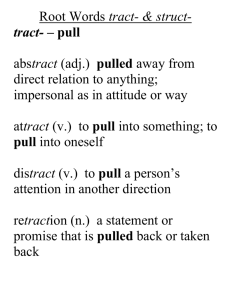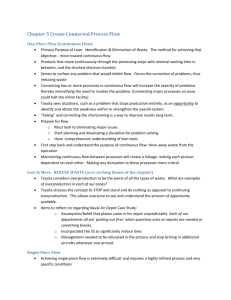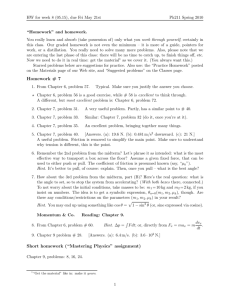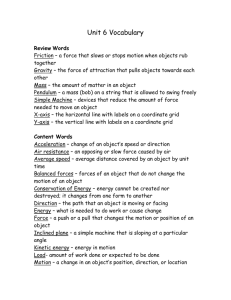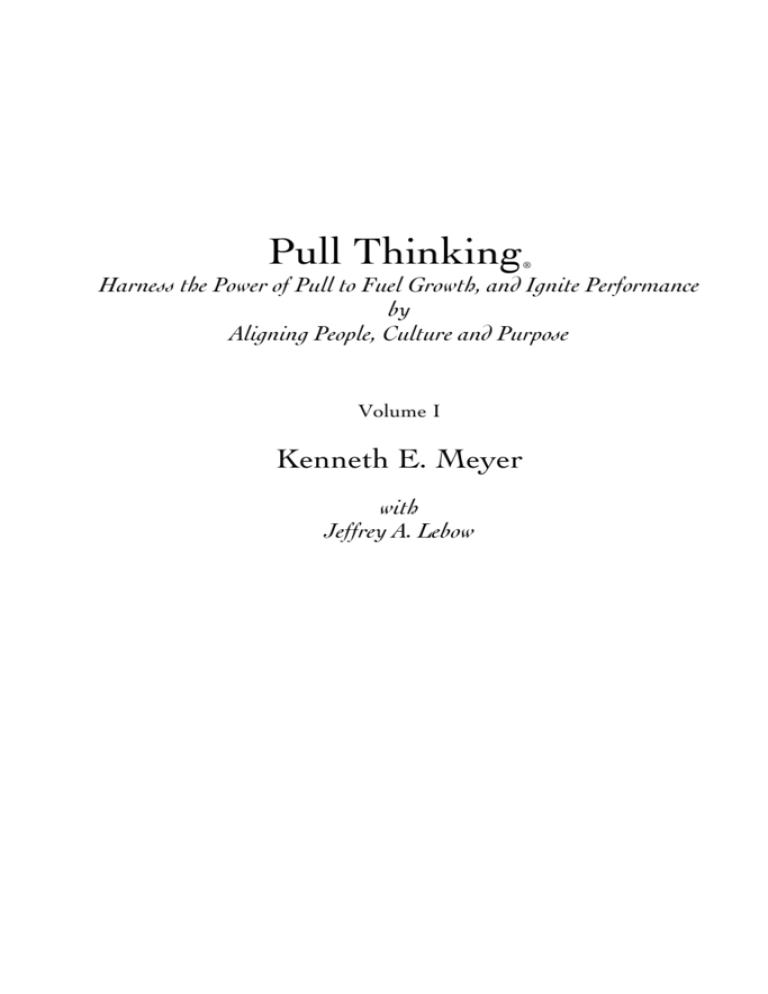
Pull Thinking
®
Harness the Power of Pull to Fuel Growth, and Ignite Performance
by
Aligning People, Culture and Purpose
Volume I
Kenneth E. Meyer
with
Jeffrey A. Lebow
—iii—
Copyright © 2002 - 2005 by Kenneth E. Meyer
All rights reserved. Published by Alignment at Work, LLC Publishing
Division, Atlanta, Georgia, USA. Reproduction or translation of any part
of this work beyond that permitted by Section 107 or 108 of the 1976
United States Copyright Act without the permission of the copyright
owner is unlawful. Requests for permission or further information should
be addressed to the Permissions Department, Pull Thinking LLC.
"Pull Thinking" is registered as a trademark and service mark in the U.S.
Patent and Trademark Office.
"Pull Principle" is registered as a service mark in the U.S. Patent and
Trademark Office.
While the Publisher has taken all reasonable care in the preparation of this
book the Publisher makes no representation, express or implied, with
regard to the accuracy of the information contained herein and cannot
accept any legal responsibility or liability for any errors or omissions from
the book or the consequences thereof.
ISBN 0-9726403-0-4 (Volume I)
Printed in the United States of America
14
13
12
11
—ii—
10
9
8
PREFACE
You seem to be doing all the right things. You are current with
what all the latest business book authors are saying and apply (as
best you can) what those thought leaders and business gurus are
saying. You are even among the very small percent that become a
model of success being written about by one of those major authors.
Yet, you find that you still have internal conflicts and
communication issues between people and teams causing tense
relationships and other difficulties. You can’t understand why this is
happening. Why isn’t everyone cooperating and happy? What’s
missing?
You have tried to apply what you read in the latest business
book, but nothing seems to stick. It seems so easy when you read
those case study examples of very successful companies like GE or
Bank of America or EDS. You keep buying those books as they
appear in hopes of finding the right solution that will ignite your
employees and turn your business around.
The question that needs to be asked is: How do your internal and
external customers want your business to be organized, to operate,
to handle financial flow, etc. Like the snow flake, there is only one
particular way that will produce the utmost best, most efficient
process that creates the product and service experiences that your
end customer wants. There is no one common formula for all of us to
follow. The reality of it is that it is an individual thing. You need to
figure out what is best for you.
Many successful businesses are led by CEO’s, mentored by other
successful leaders and or students of various business authors,
achieve ultimate successful application of what they learned to their
own businesses. Their successes are then chronicled in the latest
business success book. Thus providing a platform on which the next
business leaders build their success. And so we go.
Business authors today certainly provide great insight and advice
from the stand point of synthesizing what works for one business
leader or another. Authors attempt to discover how successful
business leaders think and often suggest copying their habits as a
way to become as successful. One author tells us to do what we are
best at and pick people to do what they are best at. Another shows
us what measurements successful companies have in common.
—v—
Pull Thinking
Another says that it’s about having a leader that knows how to
execute.
They are all heading in the right direction, and incremental
improvements are certainly accomplished by some. The problem is,
they leave out how to connect people to work together for the
customer’s benefit. All of them are high level and do not really talk
to all levels of an organization.
What’s different? Three examples:
Curt Coffman and Gabriel Gonzalez-Molina, Ph.D. in Follow
This Path, recommend emotional engagement as one of the keys to
understanding successful business leaders today. “The accepted
conclusions about emotions indicate that they are objective,
measurable, and universal to all human feelings. The implications of
the effects of emotions as they relate to the workplace and to
customer behavior are simple but powerful.” … “But emotions are
the mechanisms of our mind least understood by management –
hence the great opportunity for organizations.” … “As opposed to a
more transactional approach to leadership, an approach in which
leaders prescribe for employees what to do, transformational
leadership involves leaders broadening and elevating the interests of
their employees. This can be accomplished by creating awareness
and acceptance of the purposes and mission of the organization and
looking beyond self-interest to the interest of the group as a whole.” 1
They go on and provide the measures the leaders use to create this
awareness in an organization. The difference that Pull Thinking
brings is to tie the measurements to purposes in a structured way
within the flow of customer service. Pull Thinking provides an
excellent context for the very important measurements that the
Gallup organization presents.
Jim Collins in Good to Great has the Three Circles of the
Hedgehog Concept2 as the cornerstone of the book: 1) What you are
1
Coffman, Curt and Gonzalez-Molina, Gabriel, Follow This Path, Warner Books,
Inc, 2002 pages 235, 236
2
Collins, Jim, Good to Great, HarperCollins Puplishers, 2001, page 96
—vi—
Preface
deeply passionate about; 2) What you can be the best in the world
at; and 3) What drives your economic engine. Using this at a high
level certainly brought results to the companies chronicled in the
book, but this does not work to bring buy in and alignment to all
levels of an organization. It does not show individuals up and down
the line how to connect to the organizational structure, how to
become customer focused, or how to be empowered to solve their
own problems. It does not build teams or change mindsets. With
Pull Thinking, the three Hedgehog Concept circles are addressed
automatically. Pull Thinking ensures an internal/external customer
focus and knowledge of how to structure the environment in support
of the internal and external customers of the whole organization.
You will see how those three circles represent purposes – each
having a connection in the service flow structure discussed in Step 3.
The three circles are really Measures of Success when seen from a
Pull Thinking context (Step 1). You will learn why this is only one
of the Four Dimensions of Alignment. Purpose, Measurement and
Frequency of Measurement also need to be addressed. The three
circles also represent choices every company needs to make at all
levels. The most important aspect to note is what is missing: the
customer, both internal (employees) and external.
Larry Bossidy and Ram Charan in Execution – The Discipline of
Getting Things Done, say: “In its most fundamental sense, execution is
a systematic way of exposing reality and acting on it. Most
companies don’t face reality very well…that’s the basic reason they
can’t execute.” … “Execution is the job of the business leader.” …
“There’s a saying we recently heard: We don’t think ourselves into a
new way of acting, we act ourselves into a new way of thinking.
Acting your way into a new way of thinking begins with
demystifying the word culture…Stripped to its essentials; an
organization’s culture is the sum of its shared values, beliefs, and
norms of behavior.” … “If a company rewards and promotes people
for execution, its culture will change.” 3 Conversely this approach
will not produce maximum results because the mindset has not been
3
Bossidy, Larry and Charan, Ram, Execution – The Discipline of Getting Things Done,
Crown Business publisher, 2002, pages 22, 89 and 92
—vii—
Pull Thinking
addressed.
For that to happen, the theoretical basis for
understanding how best to change needs to change. The difference is
that Pull Thinking provides a practical organizational alignment
strategy based on profound simple ancient truth. In present day
language it allows you to make sense out of difficult problems. The
most efficient way to execute is to think your way into acting.
Thinking comes first – actions follow. To execute first and think
second is simply more difficult and more costly and the results are
less than what is possible.
The culture difference:
We are talking about culture and the fundamental building
blocks of business – PEOPLE and how people think – their
mindsets. These authors do address behavior and motivation issues.
But they fail to recognize that when thinking is addressed first these
issues become less difficult. The questions answered in this book are:
How do you provide a culture that supports the best service possible
for any business? How do you ensure profitable growth year after
year? And: How do you get Four Dimensional AlignmentSM
throughout the organization?
Many of the best-run businesses have goals and structures in
place at all levels and appear to be doing all the right things as read
in the latest business books. Yet communications problems, tense
relationships and low morale still exist. What’s different about Pull
Thinking is that it shows first why this is happening; and, second,
shows everyone at all levels what to do about it.
Pull Thinking is about a practical way for people to connect with
each other and to ultimately connect with the internal/external
customers and suppliers with a focus on purpose and service. As a
result, it creates customer-focused listening and strategic alignment
at all levels beginning at the individual level. Because of this
connectedness, there is buy-in that will make your business
processes and your customers’ business processes more successful
and sustainable. How? By addressing how we think as individuals,
—viii—
Preface
as teams, as organizations, as integral parts of the communities in
which we serve, and how to organize to always be efficiently
responsive to their changing needs.
The value difference:
With Pull Thinking three levels of value result: 1.) the individual
people that make up companies; 2.) the company’s processes and
strategies that support the individuals providing services to external
customers; and, as a result: 3.) the company’s customers. Pull
Thinking provides a Service Flow Pull Structure that connects the
whole service supply chain. Jeff Thull in his article entitled Winning
Profitable Customers said “It’s no longer enough to offer a value-added
product. You must leverage your value all the way through to your
customers’ customers…we are living and working in a time called
the ‘third era’ of professional selling – but too many sales
organizations are still operating in an outdated mindset.” In his
synopsis, he refers to this as when your services go beyond the first
level: a good price; beyond the second level: helping your customers’
processes; and into the third level: your customers’ customers benefit
from your products and services. He said that this third level of sales
professional is when: “You have become an integral part of their
business, a source of competitive advantage, you’re making their life
easier, and you’re contributing to their measurable success.”4
The bottom line:
When you make Pull Thinking an integral part of your business,
it becomes a source of competitive advantage. It makes life easier
for your company and your customers thus contributing measurable
success to both. You have fun!
4
From an article by Jeff Thull called Winning Profitable Customers, Catalyst
Magazine, June 2004, page 24
—ix—
Pull Thinking
Why write this book?
Simple—when one discovers something new and important, it’s
natural to want to share the discovery. This is one of those
discoveries.
Pull Thinking was a light bulb of discovery born out of my
frustration with implementing change in organizations. The
discovery was that the entire universe is one magnificent, elegant
Pull System! Everything nature creates is created by Pulling! Every
action is the result of a Pull. Can you think of any more perfect
creative process than Mother Nature?
What if this is how nature thinks? What if Pull Thinking is
mental ergonomics—the easiest way to think?
I needed to capture the light bulb discovery in a way that’s easy
to communicate and understand, so I framed it in what I call “The
Pull Principle” and “Pull Thinking.” Pull Thinking brings the Pull
Principle to life and makes Pull real—something we can all measure,
something we can all learn to create.
The next step was to put it to work in my life and career. As a
result of Pull Thinking, my personal effectiveness increased
enormously. Once I applied Pull Thinking, I could solve difficult
problems very quickly. Even more important, it’s been very effective
for others—I found myself able to talk to CEOs, executives,
supervisors, and shop floor workers in a way that had them listening
differently. The language of Pull Thinking made it easy for them to
open their minds to new ideas and discover solutions for themselves.
I found that we are all pulled and are pulling everyday. The
word pull is already a big part of our common language as both a
noun and a verb—“he has pull,” or “pull a team together,” or “pull
your own weight.” Sometimes we’re aware of what is pulling,
sometimes we’re not.
What if we could learn to Pull all the time—could we be more
on-target and purposeful?
We all know people who have “magnetic” personalities. What if
being “magnetic” wasn’t just something one is born with, and thus
—x—
Preface
seemingly out of our control? What if it was something we could
learn to use to create our own personal and business magnetism?
What if we could learn to Harness the Power of Pull?
Some of what you will read here may sound familiar. As time
goes on, I see more and more evidence that people are beginning to
understand the importance of understanding “Pull.” For example,
the new Science of Chaos has scientists rethinking their understanding
of the universe and talk about the elegant order underlying the
apparent chaos that is literally Pulling the creation of the universe.
In the 2005 Number 3 issue of the McKinsey quarterly, authors
John Seely Brown and John Hagel in their paper called “From push
to pull: The next frontier of innovation5” have chronicled how a few
fringe companies in the world have found the value of pull systems
over push systems. One of the key messages they write talks about
how the discovery of the power and efficiency of pull systems will
have corporate executives reassessing how they do business.
Another example: We’ve all been caught up in the push to create
vision and mission statements to pull our organizations together.
Many of us are left wondering why. These statements hang on walls
across corporate America, but more often than not, nothing has
changed in our day-to-day routine. Organizations across the country
attempt to implement and sustain various improvement initiatives,
such as balanced scorecard, six sigma, total quality, team
development, cellular manufacturing and pull systems, to name just
a few. The result? Most of us become frustrated and disillusioned
because implementation has proven to be difficult or impossible.
Pull Thinking provides the context that gives luster, passion and power to
those important statements and initiatives—and provides the tools to assure
their sustained realization and harness unseen forces to align with our efforts
drawing us towards our vision of success.
For me, the early application of Pull Thinking happened to be in
manufacturing, but I could have been in any business. It began with
a personal shift in thinking. The application is universal, because it’s
simply a different way of thinking first. Action comes second. But
this is for you to discover. Then you can apply it in your own
5
The McKinsey Quarterly, 2005 Number 3
—xi—
Pull Thinking
situation. After many years of testing, I have yet to find any
contradictions or incompatibilities. It simply always works.
Pull Thinking isn’t the result of years of studying other thinkers and
business case studies or collecting the best ideas and synthesizing
them into one principle. The discovery of the Pull Principal and Pull
Thinking came upon me in a flash. I spent the next several years
discovering new validations and learning new applications. For me,
it was like discovering fire and then figuring out how to harness its
power to keep warm, cook food, forge steel, and launch rockets.
I’ve only begun to scratch the surface of the potential of Pull
Thinking. I was “Pulled” to write this book so everyone could learn
to “Pull together.”
Kenneth E. Meyer
ken@pullthinking.com
www.pullthinking.com
Atlanta, GA
Summer 2004
“Sailing out of Chaos...”
—xii—

